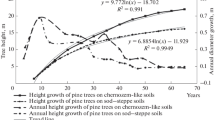Abstract
In the ecological and geological respect the sand soil stratum is considered as a component of ecological–geological systems or biogeocenoses. The characteristic ecological–geological features of sand massifs are studied. Types of sand ecological–geological systems are distinguished and their structure is described.
Similar content being viewed by others
References
Bazovye ponyatiya inzhenernoi geologii i ekologicheskoi geologii. 280 osnovnykh terminov (Basic Concepts of Engineering Geology and Ecological Geology. 280 Key Terms), Trofimov, V.T., Ed., Moscow: OAO Geomarketing, 2012.
Boehm, A.B., Yamahara, K.M., and Sassoubre, L.M., Diversity and transport of microorganisms in intertidal sands of the California Coast, Applied and Environmental Microbiology, 2014, vol. 80, no. 13, pp. 3943–3951.
Gael’, A.G. and Smirnova, L.F., Peski i peschanye pochvy (Sands and Sandy Soils), Moscow: GEOS, 1999.
Guidelines for Safe Recreational Water Environments. Vol. 1. Coastal and Fresh Waters, Genewa: World Health Organization. 2003.
Kolbel-Boelke, J., Anders, E.-M., and Nehrkorn, A., Microbial communities in the saturated groundwater environment. II. Diversity of bacterial communities in a Pleistocene sand aquifer and their in vitro activities, Microb. Ecol., 1988, vol. 16, no. 31.
Korolev, V.A. and Trofimov, V.T., History of engineering–geological study of the sand in the USSR and the Russian Federation, Inzh. Geol., 2017, no. 1, pp. 4–19.
Manucharova, N.A., Vlasenko, A.N., and Men’ko, E.V., Specificity of the chitinolytic microbial complex of soils incubated at different temperatures, Microbiology, 2011, vol. 80, no. 2, pp. 205–215.
Mendes, B., Urbano, P., Alves, C., et al., Sanitary quality of sands from beaches of Azores islands, Water Science and Technology, 1997, vol. 35, nos. 11–12, pp. 147–150.
Nestor, I., Costin-Lazar, L., Sovrea, D., and Ionescu, N., Detection of enteroviruses in sea water and beach sand, Zentralblatt für Bakteriologie, Mikrobiol. Hyg. Abt. 1, 1984, vol. 178, nos. 5–6, pp. 527–534.
Rosés-Codinachs, M., Isern Vins, A.M., Ferrer Escobar, M.D., and Fernandez Perez, F., Microbiological contamination of the sand from the Barcelona city beaches, Revista de Sanidad e Higiene Publica, 1988, vol. 62, nos. 5–8, pp. 1537–1544.
Teoriya i metodologiya ekologicheskoi geologii (Theory and Methodology of the Ecological Geology), Trofimov, V.T., Ed., Moscow: Mosk. Gos. Univ. 1997.
Trofimov, V.T., The ecological-geological system, its types and position in the structure of an ecosystem, Moscow Univ. Geol. Bull., 2009, vol. 64, no. 2, pp. 111–115.
Trofimov, V.T. and Ziling, D.G., Ekologicheskaya geologiya: Uchebnik (Ecological Geology: Manual), Moscow: ZAO Geoinformmark, 2002.
Author information
Authors and Affiliations
Corresponding author
Additional information
Original Russian Text © V.T. Trofimov, V.A. Korolev, 2018, published in Vestnik Moskovskogo Universiteta, Seriya 4: Geologiya, 2018, No. 2, pp. 59–65.
About this article
Cite this article
Trofimov, V.T., Korolev, V.A. Sand Massifs as Objects of Ecological–Geological Research. Moscow Univ. Geol. Bull. 73, 273–279 (2018). https://doi.org/10.3103/S0145875218030122
Received:
Published:
Issue Date:
DOI: https://doi.org/10.3103/S0145875218030122




